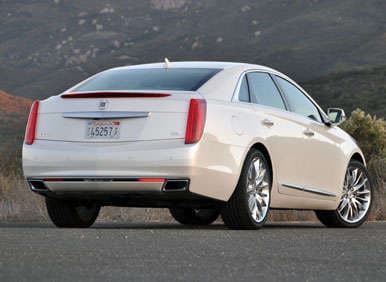Recent Articles
Popular Makes
Body Types
2013 Cadillac XTS Road Test and Review
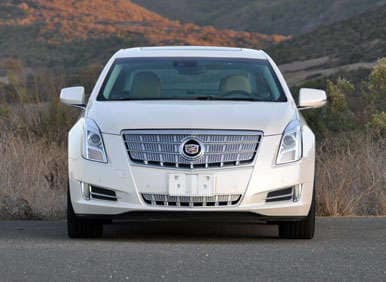
It seems like only yesterday that Cadillac decided to retire classic old car names like DeVille and Seville for modern acronyms like DTS (DeVille Touring Sedan) and STS (Seville Touring Sedan), believing such a move would reduce the amount of gray hair and wrinkles in Caddy showrooms. Now, with the arrival of the 2013 Cadillac XTS flagship sedan, the luxury brand is kicking the DTS and STS nameplates to the curb.
A large luxury sedan offered with front- or all-wheel drive and a V-6 engine, the new XTS is based on the same platform as the Buick LaCrosse and upcoming 2014 Chevy Impala, arriving at a time when Cadillac continues its bid for global credibility and relevance. Yet, as attractive and technologically advanced as the Cadillac XTS might be, it appears to be a stop-gap measure, a vehicle intended to plug a gaping hole in a “Standard of the World” product development program that was, perhaps, body-checked by General Motors’ bankruptcy and the worst recession since the Great Depression.
Why would I say that? No company claiming that it wants to be recognized as “the Standard of the World” would re-style a Buick and call it a day. Something else is coming (or had better be), a real flagship sedan that can go head-to-head with the best from Europe and Japan. In the meantime, we have the XTS to consider.
2013 Cadillac XTS Road Test and Review: Pricing and Trim Levels
The 2013 XTS is offered in a standard model or with three different “collections” of equipment, as Cadillac prefers to refer to them: Luxury, Premium, and Platinum.
The base price for the Cadillac XTS is $44,995, including the $920 destination charge. Standard equipment includes the usual suspects for a big luxury sedan, plus genuine wood and metal trim, a Bose premium sound system with HD Radio and Bluetooth streaming audio capability, a Cadillac User Experience (CUE) system with natural voice recognition technology, keyless access and push-button ignition, a power tilt/telescopic steering wheel, dual-zone automatic climate control, and more. Additionally, the XTS is equipped with a Magnetic Ride Control suspension, Brembo front braking components, 19-inch painted aluminum wheels with chrome inserts, and rear park assist sensors.
The Cadillac XTS Luxury model starts at $49,610. It includes heated and ventilated front seats, a heated steering wheel, manual thigh adjusters for the front seats, a memory package for multiple drivers, and upgraded wood cabin trim. Exteriors are dressed up with LED front running lights, dual stainless steel exhaust outlets, front and rear parking sensors, and a reversing camera.
At $54,505, the XTS Premium model includes adaptive headlights, a color heads-up display, CUE with a navigation system, a Bose Studio Surround Sound system, a 12.3-inch configurable color gauge cluster, and triple-zone automatic climate control. This model also gets a more upscale set of 19-inch aluminum wheels.
The XTS Platinum model sits at the top of the lineup, wearing a window sticker of $59,080. For that sum, buyers receive full premium leather seating, an extended leather cabin treatment, a suede headliner, an UltraView power sunroof, a power rear sunshade, manual rear window sunshades, a chrome accented grille, and polished 20-inch wheels.
All-wheel drive is optional on the Luxury, Premium and Platinum models for an extra $2,225. A Driver Awareness Package is also offered for these versions of the car, and it includes numerous safety technology upgrades. Luxury and Premium models can also be equipped with an UltraView power sunroof, while CUE navigation is offered as an upgrade on the Luxury model.
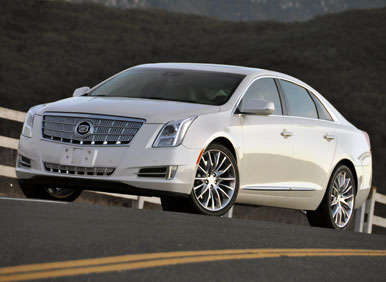
2013 Cadillac XTS Road Test and Review: What It's Up Against
Though the Cadillac XTS is positioned at the top of the lineup as the brand’s flagship sedan, it competes against mid-level models of similar size, price and market intent. These would include the Acura RLX, Audi A6, BMW 5 Series, Chrysler 300, Jaguar XF, Lexus GS, Lincoln MKS, Mercedes-Benz E-Class, and Volvo S80.
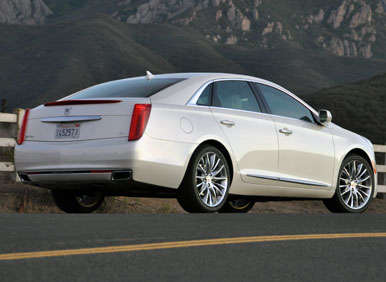
2013 Cadillac XTS Road Test and Review: Exterior
- Standard 19-inch aluminum wheels
- Optional 20-inch aluminum wheels
- Capless fuel filler system
- Illuminating door handles
- Light pipe running lights and taillights
The Cadillac XTS is an attractive automobile, one that evolves classic Cadillac design cues in a modern way, a way that ensures the XTS cannot be mistaken for anything other than a Cadillac.
From the vertical LED light pipes and ornate but not quite garish grille to the fastback roofline and vertical LED taillights capped by vestiges of classic Cadillac fins, the XTS is an exceptionally well-executed design. Details such as the scowling headlamp brows, scalloped fender tops, creased hood and beltline, metallic side spears, and an art-deco third brake light that doubles as a lip spoiler lend the car plenty of style and character. My XTS Platinum test vehicle had polished multi-spoke 20-inch aluminum wheels that looked terrific, and which I believe are necessary to give the car proper balance.
Unlike with some competitors, it is improbable that the XTS would ever be mistaken for the Buick or Chevrolet with which it shares its underpinnings. If there’s a flaw here, it’s that the wheelbase is too short, or the overhangs are too long, giving the otherwise appealing XTS an ungainly appearance from some angles.
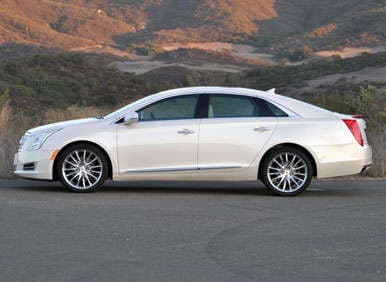
2013 Cadillac XTS Road Test and Review: Interior
- Standard Cadillac User Experience (CUE)
- Optional panoramic sunroof
- Optional reconfigurable gauges
- Optional color heads-up display
Frankly, the 2013 Cadillac XTS feels more intimate than I expected, narrower, with tighter foot wells and smaller seats. Of course, it could be that I’m just getting wider. In any case, even if the problem lay with expanding personal girth, there’s no question that the XTS Platinum offers comfortable front chairs. All they lack is a massage function.
Comfort is not a problem in the back seat, where occupants sit on a tall, supportive bench seat with no shortage of legroom. I did find, however, that when pulling my size-12 feet out from under the front seat, the laces got caught on an upholstery seam on the bottom edge of the seatback.
Around back, under that short rear deck, resides an 18 cu.-ft. trunk. It is shaped and finished like a plush cube, similar to an Audi, with fixed hinges concealed behind protective panels, premium in every respect except for a lack of a power closing function.
The Cadillac XTS looks and feels upscale inside. From our test car’s premium leather seats, extended leather cabin treatment, suede pillar trim and headliner, and real wood and metal detailing, the XTS Platinum conveys the impression that it should cost more than the window sticker says it does. In particular, the thick-rimmed steering wheel is a work of art, terrific to grip and pleasing to behold.
There are areas that feel inexpensive, though, primarily related to the center console, which houses a too-tall gearshift that looks like it may have been yanked out of a 1998 Seville, and a power port cubby that lacks the flocked lining of other storage areas.
The main problem with the Cadillac XTS, however, is its CUE system. Designed to simplify the complexities of modern automobiles, CUE in the process manages to add complexity to what ought to be simple executions. For example, even after consulting the owner’s manual and spending 10 minutes trying to find the right screen or menu to do so, I could not figure out how to modify the radio station presets.
Granted, nobody in my family has ever equated me to a technology whiz, but I manage to acclimate to products sold inside the Apple store without any trouble at all. I can even use Siri without once referencing a manual.
With this Cadillac, I often found myself stuck in technological cul-de-sacs within a fun-house maze of software code. Ironically, Cadillac provides each new XTS buyer with an iPad pre-loaded with a CUE application designed to help dealers and customers familiarize themselves with the system.
Making matters worse, the capacitive touch display frequently responded incorrectly, or did not respond at all, revealing a need for CUE’s operator to be deliberate and precise in issuing touch commands. Haptic feedback in the form of a subtle vibration is designed to give the operator affirmation that CUE has received your touch command, but it appears to be inconsistently applied, and as a result the driver continually seeks visual confirmation that the system got the message by consulting the in-dash screen, the gauge screen, and the head-up display.
Oh, how I wished for a few simple knobs and big buttons.
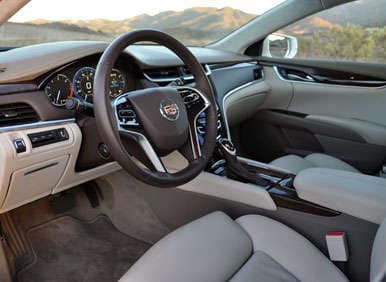
2013 Cadillac XTS Road Test and Review: Matters of Safety
- 10 standard airbags
- Safety Alert Seat
- Forward Collision Warning
- Automatic Collision Preparation
- Automatic Front and Rear Braking
- Rear Cross Traffic Alert
- Adaptive Forward Lighting
On the previous page, I went into detail about why I think Cadillac’s new CUE technology is half-baked. What I didn’t say right out loud is that the system is an enormous distraction while driving. If an argument ever existed for automated cars, the new XTS is it*.
Let’s put it this way. I was definitely grateful for the XTS Platinum’s 10 standard air bags, lane departure warning system, forward collision alert with safety alert seat, automatic front and rear braking, and automatic collision preparation. It would almost seem that even if I wanted to crash the XTS, I wouldn’t be able to. And if I did, the car’s NHTSA 5-star overall crash-test rating and the OnStar Automatic Crash Response system would protect me and speed rescuers to the scene.
As much as I like the safety alert seat concept, however, I acclimated to it and learned to ignore it because sometimes the Cadillac would sound the alarm without reason (when passing over drainage dips or when a car in the adjacent lane would brake to make a right turn), and sometimes it wouldn’t with reason (when zooming up on slower traffic). I couldn’t figure out what made it tick, and it didn’t seem to execute consistently, so I decided it might not really know what it was doing and therefore could not be trusted.
*To be fair to Cadillac, I think that most of these voice-recognition and touch-sensitive display screens with smartphone pairing capability are accidents waiting to happen. Some are definitely easier to use than others, and none of them bother me if I can operate the stereo and climate controls independently.
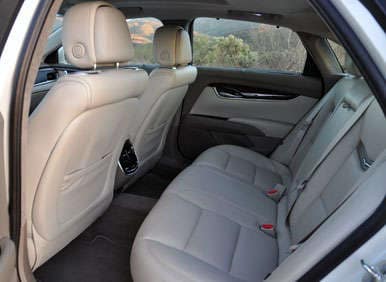
2013 Cadillac XTS Road Test and Review: Powertrain
- 3.6-liter V-6 engine
- Six-speed automatic transmission with paddle shifters
- Brembo front braking components
- Hi-Per Strut front suspension
- Rear air suspension
- Optional all-wheel-drive system
A tried-and-true 3.6-liter V-6 engine is the only choice for the 2013 XTS, marking the first time Cadillac has sold its largest sedan without a V-8 since, umm, a long time ago. If you want a V-8, buy an Escalade or a CTS-V.
The direct-injected V-6 generates 304 horsepower at 6,400 rpm and 264 lb.-ft. of torque at 5,200 rpm, with a 6-speed automatic directing power to the front wheels. Paddle shifters – more like padded buttons, really – give the driver manual control over gear changes.
An all-wheel-drive system is optional, equipped with a Haldex limited-slip differential that distributes power front to rear and, on the rear axle, from side to side as driving conditions warrant. If you ask me, the AWD system adds cost, weight, and complexity that you probably don’t need.
Cadillac says our XTS Platinum test car with AWD should return 17 mpg in the city, 26 mpg on the highway, and 20 mpg in combined driving. I averaged 20.7 mpg, with most of those miles travelled on the highway. A Premium Care Maintenance Plan providing free scheduled service visits for the first four years or 50,000 miles of ownership is standard with every XTS.
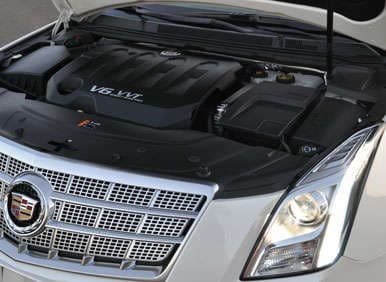
2013 Cadillac XTS Road Test and Review: How It Drives
Big Cadillacs are known for their wide front seats, finger-light steering, and plush, quiet highway ride quality. Fans of that brand of luxury won’t like the 2013 XTS, which infers that perhaps enthusiast drivers will like this big new Caddy. That’s not true, either.
Equipped with a Magnetic Ride Control suspension, a Hi-Per Strut front suspension, and a rear air suspension, the XTS displays a remarkable lack of squat, dive, and roll, though on rare occasion the car does pitch and wallow. The unfortunate side effect is that the XTS also feels too stiff, sometimes brittle, and entirely out of expected character when driven on anything but glass-smooth road surfaces.
On a positive note, the variable effort steering and braking system, equipped with standard Brembo components up front, work exactly as expected the majority of the time. Take the XTS on a favorite back road, and some drivers are likely to wish the steering offered a little bit of extra heft.
The 3.6-liter V-6 engine is powerful enough, and it sounds good when revved, but nobody will buy the XTS with the intention of running it to redline. The 6-speed automatic occasionally hangs and stumbles as it tries to decide what the driver will require next, putting a dent in the driver’s opinion of the drivetrain’s refinement.
As I do with every test car, I took the XTS Platinum for a rousing run across the Santa Monica Mountains near Los Angeles, its 20-inch tires frequently squealing under the duress. Here, the aging platform upon which the XTS is constructed made itself evident. Charging up hillsides, road shock traveled up the steering column to my palms as the front tires scrabbled for purchase out of corners. Sluicing down hills, the steering column creaked whenever I tossed the Caddy into a right-hand turn. Structurally, the car felt too light, and too loose.
The good news is that the V-6 had no trouble tackling the mountains, the suspension did an excellent job of controlling body motions, the steering proved accurate, and the brakes suffered zero fade. Still, there was little joy to be found in this exercise.
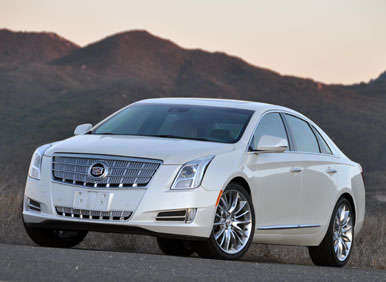
2013 Cadillac XTS Road Test and Review: Final Thoughts
Aside from technology that could some extra development time, the 2013 Cadillac XTS is a decent car, a clear advancement over the DTS and STS that it replaces. There is an audience for this big Caddy sedan, one that values its upscale design, comfortable and roomy cabin, and powertrain layout. Unfortunately, that same audience is likely to become utterly frustrated by CUE, and, in the process, utterly disenfranchised with Cadillac.
Perhaps that’s the point, eh?
In the long run, Cadillac must build a great flagship sedan to regain its “Standard of the World” status. That great flagship sedan doesn’t necessarily require a V-8 engine and rear-wheel drive, but it must be competitive with the Audi A8, BMW 7 Series, Jaguar XJ, Lexus LS, Mercedes-Benz S-Class, and Porsche Panamera. It must look the part, it must act the part, and it absolutely must reek of quality, competence, and class.
This Cadillac XTS ain’t it.
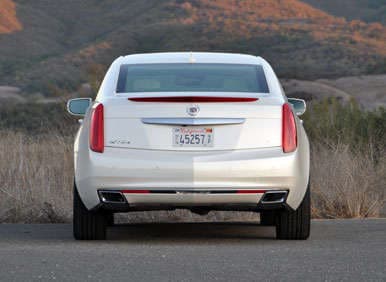
2013 Cadillac XTS Road Test and Review
- Gorgeous design and detailing
- Upscale cabin with genuine materials
- Lots of available safety technology
- Top-notch crash-test rating from NHTSA
- Comfortable seats and a big trunk
- CUE
- Fuel economy
- Occasionally jarring shifts
- Occasionally busy ride quality
- Safety Alert Seat that, just like the boy, cries “Wolf!”
Cadillac provided the vehicle for this review
2013 Cadillac XTS photos by Christian Wardlaw
